 |
Focus features two in-depth reviews each month of fine art, architecture and design exhibitions and events at art museums, galleries and alternative spaces around Japan. The contributors are non-Japanese residents of Japan. |
|
|
 |
 |
 |
Terrada Art Complex: Patronage Powers Galleries
Lucy Birmingham |
 |
Masami Shiraishi, Director of SCAI Park. Photo by Lucy Birmingham |
"Eviction" became the byword for many of Tokyo's established contemporary art galleries as they crisscrossed the city seeking cheaper rents, often one step ahead of the wrecking ball. But finally last fall, the landscape shifted with the opening of two permanent art facilities backed by corporations with a modern taste for old-style art patronage.
Complex665 is a new three-story building in Roppongi housing three galleries -- Taka Ishii, ShugoArts, and Tomio Koyama. Managed by the Mori Building Co., it sits in the heart of Roppongi's burgeoning art scene, on a side street near the gallery-infused Piramide Building.
SCAI Park signage. Courtesy of SCAI The Bathhouse; photo by Nobutada Omote |
Further south is the Terrada Art Complex on Tennozu Isle, an up-and-coming hip art hub along the industrial shores of Tokyo Bay. The five-story repurposed warehouse is owned and operated by Warehouse Terrada, a company that specializes in fine art and wine storage. It originally opened with four galleries -- Urano, Kodama Gallery, Yamamoto Gendai, and Yuka Tsuruno Gallery. In March this year, two more galleries were added to its roster of art services and facilities: SCAI Park (run by SCAI The Bathhouse) and the brand new Kosaku Kanechika gallery.
For Masami Shiraishi, director and owner of SCAI The Bathhouse, it was the five-meter-high ceilings, roominess, humidity control and total air conditioning at Terrada that convinced him to open his third space there. "This is a new direction for us, a combination art storage and gallery. Now I can keep our inventory and our clients' inventory here in one location. Before we had it stored in three separate warehouses. And this way I can now sell artworks I bought 25 years ago when I first began my career."
 |
|
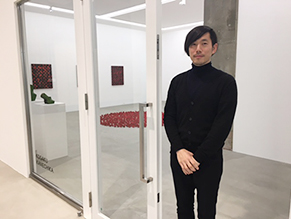 |
|
Anish Kapoor, Monochrome (Garnet) (2015), fiberglass and paint, 188 x 18 x 39 cm. Private collection; courtesy of SCAI The Bathhouse |
|
Kosaku Kanechika, Director of Kosaku Kanechika gallery. Photo by Lucy Birmingham |
The name SCAI Park reflects the new concept, with "park" derived from "parking space," he explains. The glass walls offer enticing views of the works on display as well as of Shiraishi's "back room," arranged like a comfortable living room where he can invite visitors and collectors.
SCAI Park's opening show included inventory by Darren Almond, Daniel Buren, Jenny Holzer, On Kawara and Lee Ufan. "If a buyer wants to see works by Lee Ufan, for instance, we can immediately take out examples from our storage and put them on display," says Shiraishi. "We even have an exclusive VIP entrance," he adds with a laugh, pointing to their private warehouse elevator.
The gallery's second show, from 20 May to 3 June, will feature works from private collections and include Anish Kapoor, Daisuke Ohba, Kohei Nawa and Naoki Ishikawa.
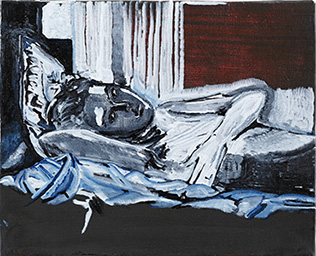 |
|
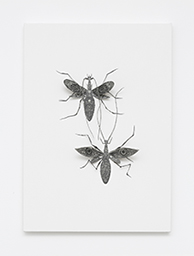 |
|
Ataru Sato, Courtship (2017), ink on canvas, 22.2 x 27.3 cm. © Ataru Sato; courtesy of Kosaku Kanechika; photo by Keizo Kioku |
|
Ataru Sato, Q1 (2017), pencil on paper mounted on panel, 42.0 x 29.8 x 6.0 cm. © Ataru Sato; courtesy of Kosaku Kanechika; photo by Keizo Kioku |
Shiraishi says he's enjoying the shared atmosphere of the Terrada Art Complex, especially after many years of going it alone at SCAI's original location, a converted bathhouse in Tokyo's Yanaka district. "My clients can see works by young artists in the other galleries, which I think is very interesting for them," he says with a nod to his new neighbor, the Kosaku Kanechika gallery. "I'm very lucky to be here."
Gallery director Kosaku Kanechika says the feeling is mutual. As the former manager of Tomio Koyama for 14 years, he is well versed in running an art gallery, but grateful to be next to veteran Shiraishi. "I'm just starting and Shiraishi-san is a long-timer, so it's a good synergy," he says.
For a new gallerist, finding a decent, affordable space in Tokyo is like searching for the proverbial needle in a haystack. "I saw maybe 20 or 30 spaces, but couldn't find anything good within my budget. Warehouse Terrada Company really supported me." The fact that Terrada owns the warehouse is a big advantage, he explains. Tomio Koyama and other galleries in the popular Kiyosumi-Shirakawa warehouse art complex were evicted when the building was sold.
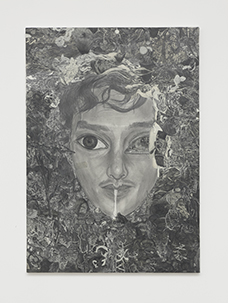 |
|
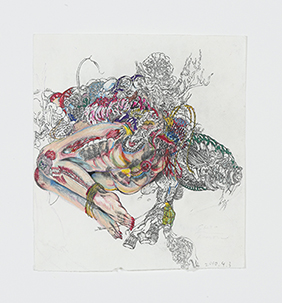 |
|
Ataru Sato, his sea (2014), pencil, color pencil, ink on paper mounted on panel,
84.1 x 59.4 cm. © Ataru Sato; courtesy of Kosaku Kanechika; photo by Keizo Kioku (not included in exhibition) |
|
Ataru Sato, Serious Injury (2010), pencil, color pencil, ink on paper, 23.0 x 20.6 cm.
© Ataru Sato; courtesy of Kosaku Kanechika; photo by Keizo Kioku (not included in exhibition) |
Kanechika admits the Terrada space is a bit far from central Tokyo. "But there are six galleries here, so it's actually a convenient place to see contemporary art," he says.
His second exhibition from 20 May to 24 June is a one-man show of collages, drawings and recent paintings by the young, up-and-coming artist Ataru Sato, formerly with Gallery Koyanagi. "The work reflects his inner world," explains Kanechika, who now represents Sato. "He is a true artist who can deeply express himself through his work." Titled Courtship, the show explores Sato's hesitation to express his art, and his struggle to find connection with others.
"His works also have sexual content which is interesting, I think, and unusual for artists in Japan," adds Kanechika, showing me the painting titled Courtship, as well as others not in the show. Some of the works would likely court controversy. "He's always drawing sexual images, but I'm being very careful about controlling which works are shown publicly. In the U.S. they would probably not be acceptable, but maybe alright in Europe."
 |
|
 |
|
Ataru Sato, Full-length Portrait (2012), pencil on paper, 51.0 x 36.0 cm. © Ataru Sato; courtesy of Kosaku Kanechika; photo by Keizo Kioku (not included in exhibition) |
|
Ataru Sato, Now (2015), ink on paper, 31.0 x 23.0 cm. © Ataru Sato; courtesy of Kosaku Kanechika; photo by Keizo Kioku (not included in exhibition) |
Europe, it seems, is a potential market for this ambitious artist. The Belgium-based art gallery Office Baroque now represents Sato outside of Japan and will take his work to the Frieze art fair in London and New York this year. They will also hold his first European solo show at their gallery in Brussels next year.
While eviction still threatens many of Tokyo's new contemporary galleries, art patronage is finally coming to the rescue for some. With so many talented contemporary artists, though, it's inexplicable why patronage remains an anomaly in Japan.
 |
|
 |
 |
Lucy Birmingham
Lucy Birmingham is a long-time, Tokyo-based journalist, scriptwriter, author, and former photojournalist. She recently served two years as president of the Foreign Correspondents' Club of Japan. She has written regularly for TIME magazine and her articles have appeared in many publications, including the Wall Street Journal, Newsweek, Bloomberg News, and Architectural Digest. As an arts and culture writer her articles have appeared in publications including Artinfo.com, Artforum.com, and ARTnews. She is also a scriptwriter and narrator for NHK (Japan's public broadcaster) and has published several books including Strong in the Rain: Surviving Japan's Earthquake, Tsunami, and Fukushima Nuclear Disaster. lucybirmingham.com |
|
 |
|